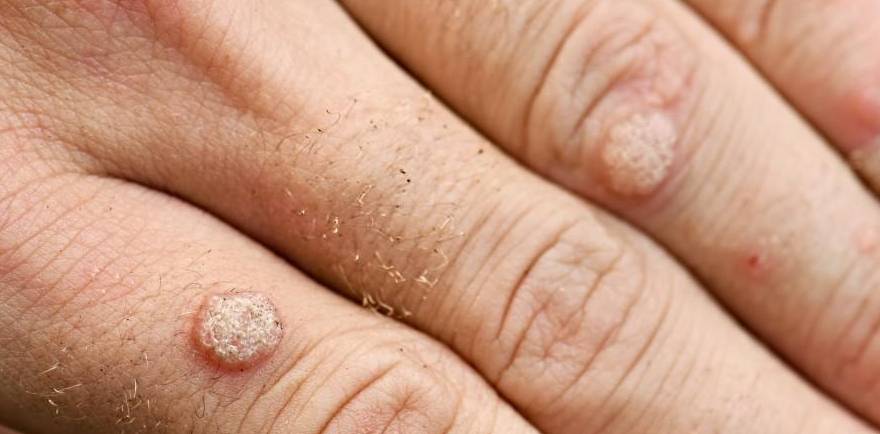What Are Warts? - Explained by Dr. Yeung Ho Hong (楊浩康)

Many patients, whether adults or children, often notice small protrusions on their skin, which are likely what we refer to as “warts” (疣). Warts are primarily caused by the human papillomavirus (人類乳頭瘤狀病毒, HPV) and are a contagious skin condition. The virus enters the skin’s stratum corneum through tiny abrasions, triggering abnormal cell proliferation in localized areas, resulting in small, firm, protruding lesions on the skin. These lesions can appear on various parts of the body and come in multiple types, with common clinical examples including common warts (尋常疣) and flat warts (扁平疣).
Common warts (尋常疣) are the most frequent type, characterized by a rough, irregular surface and a diameter typically ranging from 5 to 10 millimeters. They often appear on the hands or fingers—areas frequently in contact with the external environment—making them easily transmissible through skin contact. When larger or subjected to frequent friction, common warts may cause localized discomfort or even pain. They generally have a hard texture, and treatment often involves a combination of physical or chemical methods, such as cryotherapy (冷凍治療) or salicylic acid ointment (水楊酸軟膏), to facilitate the shedding of the affected tissue.
Flat warts (扁平疣), on the other hand, primarily occur on the face, neck, and upper body. They are very small, with a diameter of about 1 millimeter, but can appear in large numbers. These warts are slightly raised, often light brown or close to the skin tone, and while individual lesions are minor, their clustering on the face or other visible areas can significantly affect appearance. Due to their numerous and widespread nature, treatment for flat warts may involve topical medications, as well as laser therapy (激光治療) or phototherapy (光療) in some cases, to promote their regression.
Beyond common warts and flat warts, other types include plantar warts (平足疣) and mosaic warts (馬賽克疣), each with distinct clinical features. Plantar warts are commonly found on the soles of the feet, appearing thick and hard due to weight-bearing pressure, while mosaic warts form larger lesions from the fusion of multiple warts, posing greater treatment challenges. These diverse wart types are caused by different strains within the HPV family, with varying transmission mechanisms and treatment approaches.
HPV spreads primarily through direct skin contact and indirect contact. For instance, when an infected person scratches or rubs a wart, the virus may adhere to their hands, potentially infecting other skin areas upon contact. Additionally, sharing towels, toys, or other personal items can serve as a medium for viral transmission. Thus, maintaining good personal hygiene and avoiding the shared use of potentially contaminated items are effective preventive measures against wart spread.
In terms of treatment, while some cases of molluscum contagiosum in children may resolve spontaneously within months due to the immune system’s natural response, medical intervention is recommended for persistent cases or those affecting appearance. Common treatment methods include laser therapy (激光治療), cryotherapy (冷凍療法), electrocautery (電灼術), and chemical agents. Carbon dioxide laser (二氧化碳激光, CO2 laser), with a wavelength of 10,600 nm, is a widely used option that rapidly vaporizes the abnormal tissue within the wart. Post-treatment, the skin in the treated area typically heals within 1 to 2 weeks, with most cases requiring only 1 to 2 sessions for satisfactory results.
Chemical treatments often utilize keratolytic agents like salicylic acid (水楊酸), which soften and dissolve the wart, making it easier to remove through topical application or natural shedding. In some cases, electrocautery or cryotherapy may be combined to completely eliminate the lesion. Depending on the size, number, and distribution of the warts, doctors tailor individualized treatment plans to minimize recurrence and side effects.
To summarize, warts are a common infectious skin disease caused by human papillomavirus infection. Adults and children can develop various types of warts, such as common warts and flat warts. These warts usually appear as granular bumps with a rough or smooth surface, and are cosmetically disfiguring. In most cases, a combination of laser, cryotherapy, electrocautery and chemical agents is required, except in some cases where the warts are self-limiting and gradually subside. Through scientific and rational treatment, together with good personal hygiene and preventive measures, most patients can successfully control the disease and restore normal skin condition.
